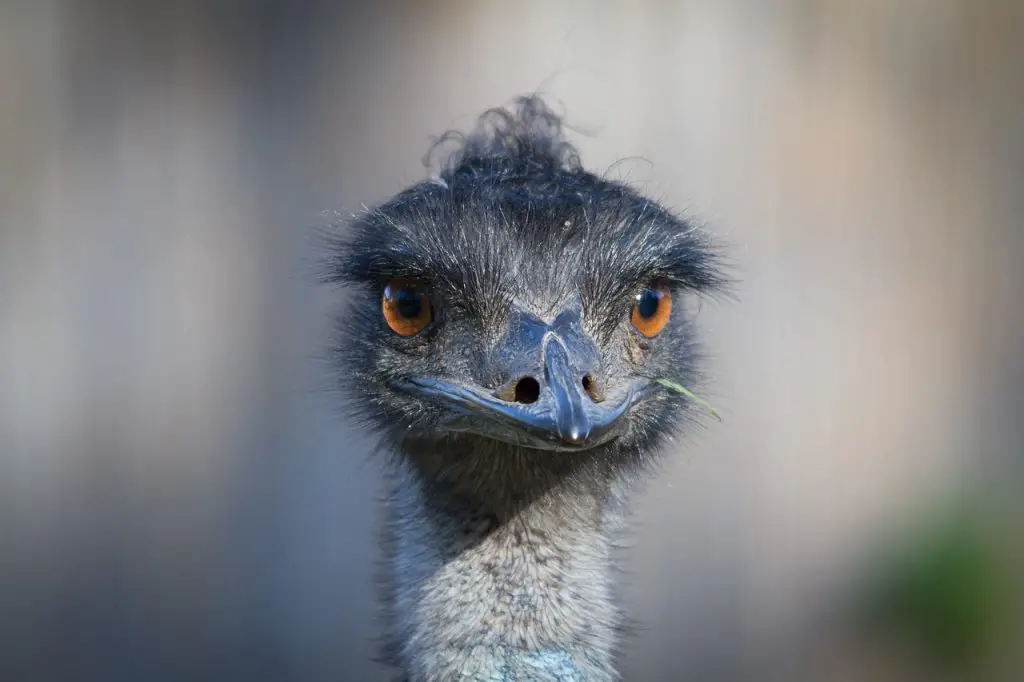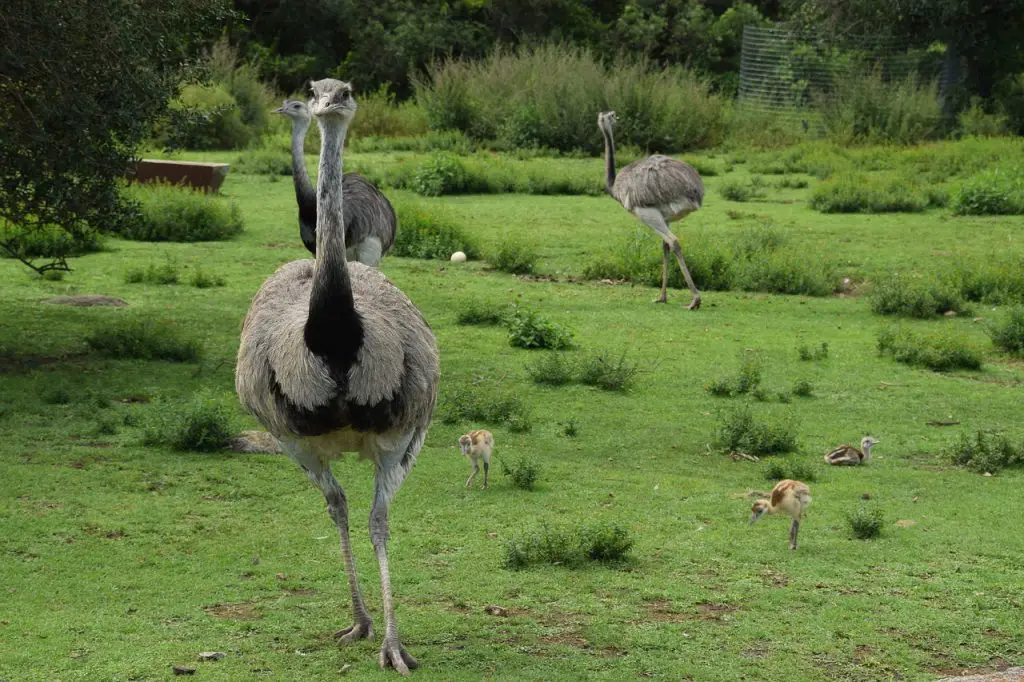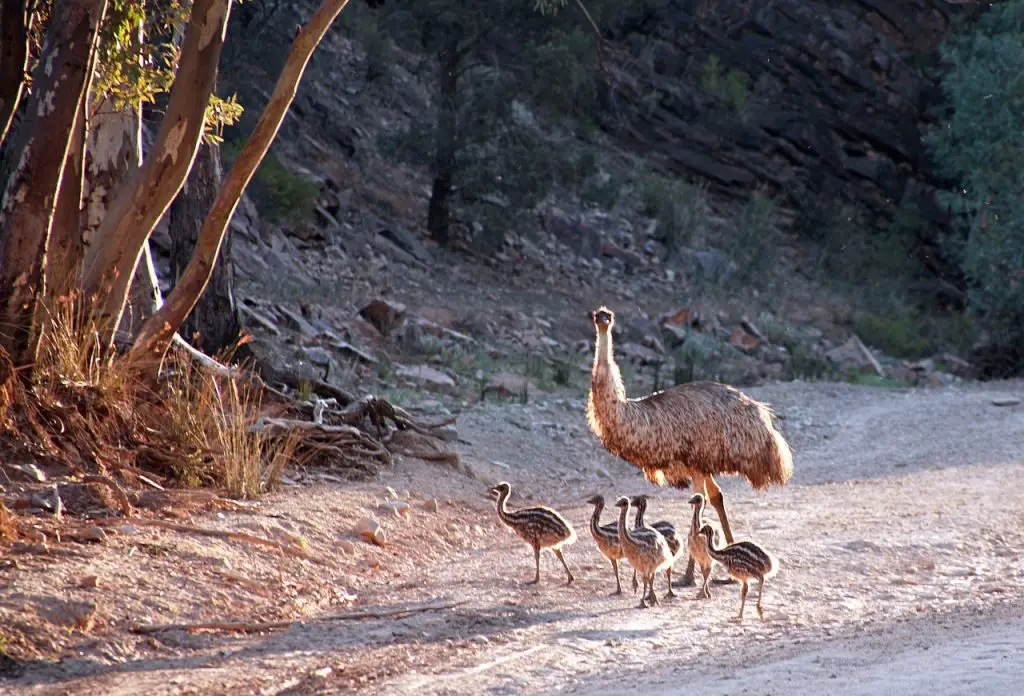Baby emus are undeniably cute. If you’ve never seen an emu chick in person, you are missing out. Luckily for you, I’ve pulled together everything you need to know about these adorable chicks. Plus, I share plenty of pictures of these photogenic baby birds.
Let’s dive in!
Key facts:
- Baby emus are the adorable offspring of emus. But there is no specific name for an emu chick.
- Emus are considered the third-largest bird in the world.
- Emus weigh around .05 kgs (17.5 oz) at birth. They can grow to be 55 kgs (121 pounds)!
Emus: What Are They and Where Do They Live?

Emus, flightless birds, are among the largest avian species inhabiting the planet today. Standing tall at an impressive height of up to 5.7 feet (~2 meters) and weighing around 90 to 121 pounds (40 to 55 kilograms), these long-legged wonders possess an extraordinary physical presence. Their distinctive appearance features a brownish-black plumage, highlighted with hints of gray on their neck and head.
Emus have small wings compared to their robust bodies. In fact, their wings are just around 8 inches (20 cm). The little wings serve as balancing aids for these big birds while running. They are adorned with strong, clawed feet, perfect for dashing through the vast landscapes they inhabit.
Indigenous to Australia, emus have carved out a diverse geographic distribution across the continent. From the coastal regions to the arid interiors, these remarkable birds have managed to adapt and thrive in various environments. You can find them wandering through grasslands, savannas, and forests, as well as exploring desert fringes and rugged mountainous terrains. As adaptable omnivores, emus predominantly feast on plants, including leaves, fruits, and seeds. Additionally, they opportunistically consume insects and small animals to supplement their diet.
In the animal kingdom, emus belong to the ratite group, a classification that includes other flightless birds like ostriches, cassowaries, and kiwis. Despite their inability to fly, these birds are exceptional runners, capable of reaching speeds of up to 31 miles per hour (50 kilometers per hour). Their powerful legs and muscular build contribute to their remarkable agility, allowing them to evade predators effectively.
What Does a Baby Emu Look Like?

As they hatch from their large green eggs, they emerge covered in soft, fluffy feathers, which range in color from a creamy white to a light brown. These downy feathers provide essential insulation and protection during their vulnerable early days. The chicks’ eyes are large and bright, surrounded by a distinctive patch of dark brown or black skin that adds to their endearing appearance.
What Does an Emu Egg Look Like?
An emu’s egg measures approximately 13 by 9 cm in diameter and weighs around 1.1 to 1.8 pounds (400 to 700 grams). The egg’s exterior showcases a smooth, pale-green surface, providing a protective shell for the developing chick inside. Its size and thickness play a crucial role in safeguarding the delicate embryo during the incubation period.
How Big Is a Baby Emu?
In terms of size, baby emus are a stark contrast to their towering adult counterparts. At birth, they stand at an average height of about 8 to 10 inches (20 to 25 centimeters). Despite their diminutive size, they boast disproportionately long legs compared to the rest of their bodies, hinting at their eventual impressive growth. These long legs serve a practical purpose, allowing the chicks to scurry around and keep up with their fast-moving parents.
How Much Does a Baby Emu Weigh?
A baby emu, also known as a chick, typically weighs around 15.5 to 17.6 ounces (440 to 500 grams) at birth. As they grow and develop, their weight increases steadily, setting them on the path to becoming strong and resilient members of the emu community.
When Does a Baby Emu Become a Juvenile Emu?
In general, baby emus start to transition into juveniles around three months old. By around 6 months old, the baby emu wills tart to develop adult plumage. The development continues for another 12 to 15 months, eventually, the bird transitions into adulthood. By around age two or three, emus are sexually mature.
What Do Juvenile Emus Look Like?
As baby emus continue to grow, their downy fluff gradually transforms into sleek juvenile feathers. These feathers are darker in color than their initial down and aid in their gradual transition into adulthood. At this stage, their legs become more pronounced, emphasizing their future running prowess. Juvenile emus exude a sense of curiosity and playfulness as they explore their surroundings, often engaging in playful behaviors with their siblings and other members of the emu community.
Emu Courtship and Mating
During the breeding season, female emus engage in rhythmic drumming, where they thump their legs against their bellies to create deep, resonating sounds. Additionally, the males may puff up their chests and stretch their necks, showcasing their vibrant throat pouches adorned with striking hues of blue.
During mating, the female lays a clutch of large green eggs, which the male dutifully incubates and cares for. After the female lays some eggs in the male’s nest, she moves on. In some cases, she’ll lay additional eggs in the nest of other males. This remarkable role reversal in parenting responsibilities is a unique trait among emus, where the males take charge of egg incubation and rearing the chicks.
While incubating the eggs, the male guards the nest. He doesn’t leave it even to eat or drink. If something gets too close to the nest, the male will defend it.
When Do Emus Lay Eggs?
Emus typically lay their eggs during the cooler months, from April and June. This period aligns with the Australian winter, which provides an advantageous environment for the incubation and development of the eggs. The female emus carefully select suitable nesting sites, often opting for sheltered spots to protect their precious clutch from harsh weather conditions and potential predators.
How Long Do Emu Eggs Take To Hatch?
The incubation of emu eggs usually lasts around 56 days. Once the chicks hatch, the males tend to be even more aggressive.
How Many Eggs in an Emu Clutch?
In an emu clutch, the number of chicks can vary, with the average clutch size ranging from five to fifteen eggs. During the incubation period, the male diligently tends to the eggs, providing the necessary warmth and care for their successful development. As the incubation nears its end, the eggs begin to hatch, giving rise to the charming sight of baby emus breaking free from their shells.
Emu Chick Rearing

After the eggs hatch, the male takes on the crucial role of caring for and protecting the adorable baby emus. The chicks are covered in soft downy feathers and are remarkably independent from birth, capable of walking and following their father within hours.
What Do Baby Emus Eat?
The male emu diligently guides and nurtures the chicks, teaching them essential survival skills and introducing them to their omnivorous diet of plants, insects, and small animals. Under his watchful eye, the chicks learn to forage for food, explore their surroundings, and recognize potential dangers in their environment. The male’s dedication to their well-being is evident as he shields them from harsh weather conditions and potential predators, ensuring their safety and growth.
Do Parents Feed Baby Emus?
The male emu doesn’t directly feed the chicks. Instead, the chicks learn how to survive by following their parent around.
How Long Do Baby Emus Stay With Their Parents?
Baby emus remain under the care and guidance of their parents for an extended period, fostering a strong familial bond. At around six to eight months of age, the baby emus become increasingly independent, gradually venturing further from their parents. This period marks the start of their transition to adulthood, where they will eventually form their own social groups within the emu community.
However, the strong familial bond formed during the chick-rearing phase remains a significant aspect of their social interactions throughout their lives. The cooperative and nurturing parenting exhibited by the emu males ensures the successful integration of the baby emus into the diverse and captivating world of these remarkable flightless birds.
Do Baby Emus Look Different as Males vs Females?
Distinguishing between male and female emu chicks can be challenging during their early stages of development. At hatching, both male and female chicks appear quite similar in size and physical characteristics. Their downy feathers are typically a light, creamy color, and they share the same behaviors and mannerisms as they follow their parents and explore their surroundings.
As the chicks mature, slight differences may start to emerge, but they are not always easily discernible. In some cases, the females may have slightly larger body sizes compared to the males, but this is not a foolproof method for identification. Additionally, behavioral cues may provide some clues, as male chicks may show more assertive and outgoing tendencies compared to their female counterparts.
To accurately determine the sex of emu chicks, it is necessary to wait until they reach their juvenile stage, which occurs after several months. As the chicks grow, their juvenile feathers start to come in, and their overall size and physical characteristics become more apparent. At this stage, it becomes easier to differentiate between male and female emu chicks based on size, feather coloration, and other sexual dimorphic traits that become more evident with time.
Baby Emus: Frequently Asked Questions
You have questions about baby emus. I have answers.
What do you call a baby emu?
There is no specific name for emu chicks. Instead, they are just chicks. (But they are pretty adorable checks!)
Are baby emus friendly?
Baby emus can exhibit friendly and curious behavior, especially when raised in captivity with regular human interactions. They may approach people with interest and often display a certain level of trust. However, it’s essential to remember that emus, like all wildlife, are wild animals, and their behavior can be unpredictable.
Can you keep an emu as a pet?
Keeping an emu as a pet can be a challenging endeavor due to various factors. Emus are large, flightless birds with specific needs that can be difficult to meet in a domestic setting. They require ample space to roam and thrive in a social environment, often forming close bonds with other emus. Additionally, emus can be unpredictable and potentially aggressive, making them unsuitable for inexperienced or unprepared owners. Therefore, it is crucial to thoroughly research and consider the legal, practical, and ethical implications before attempting to keep an emu as a pet.
Final Take on Baby Emus
Baby emus are some of the most adorable hatchlings of the bird community. While some new chicks are a little rough around the edges, these chicks seem to emerge with an adorable look immediately.